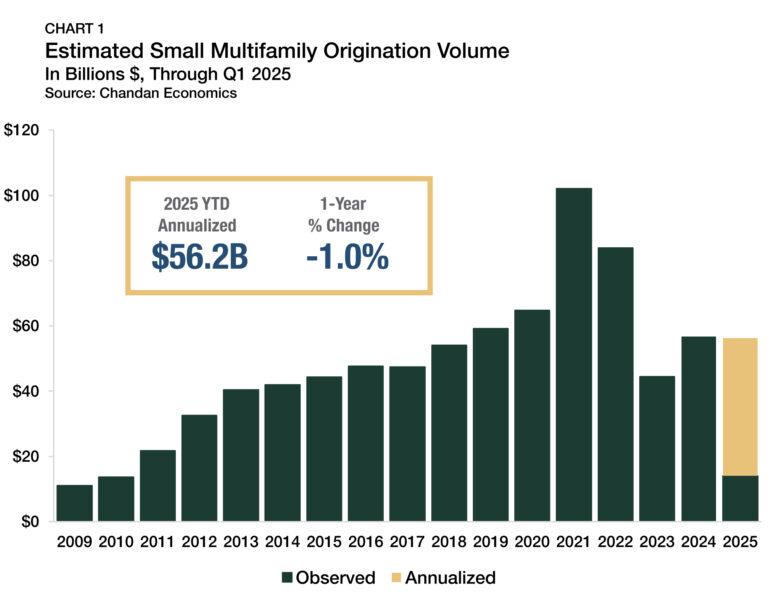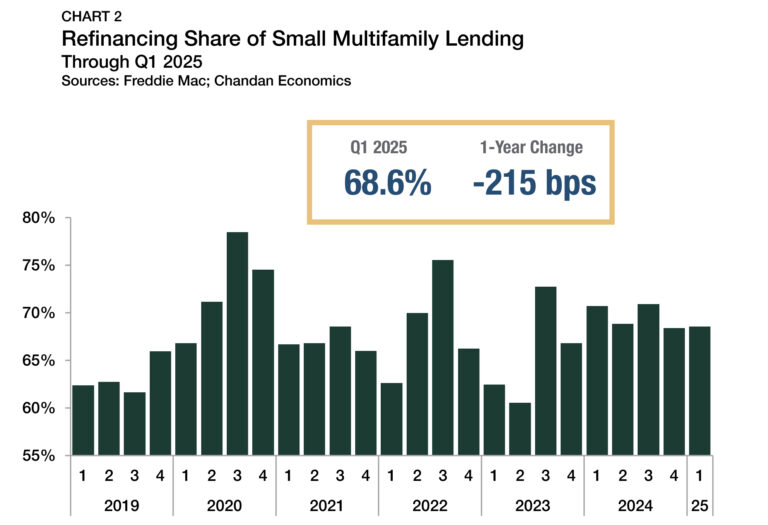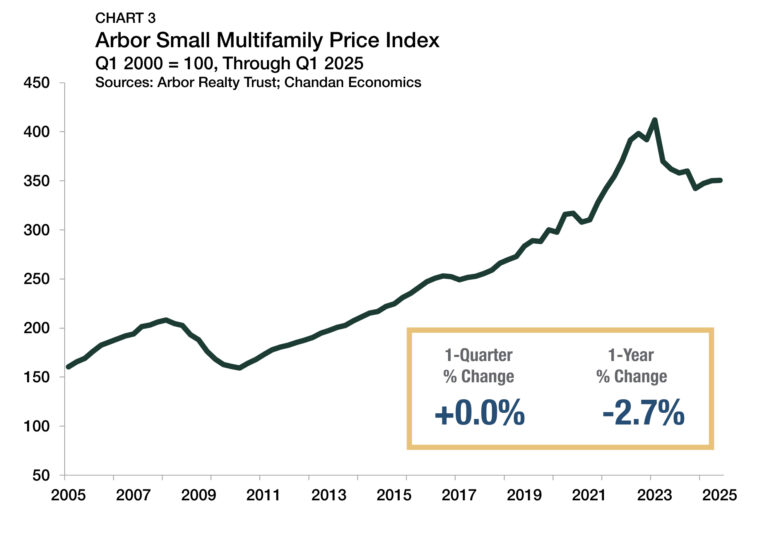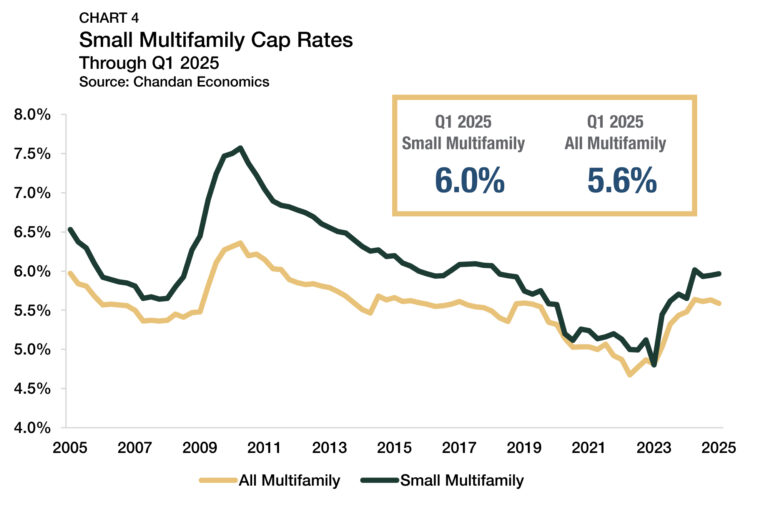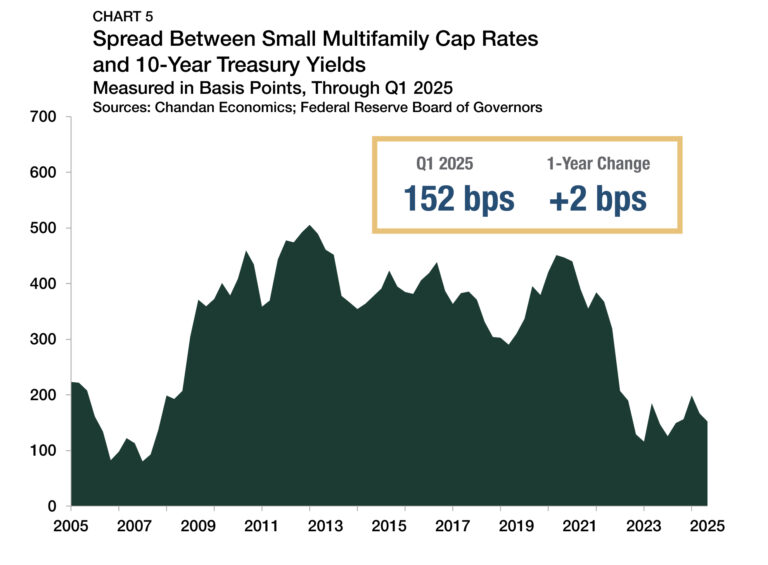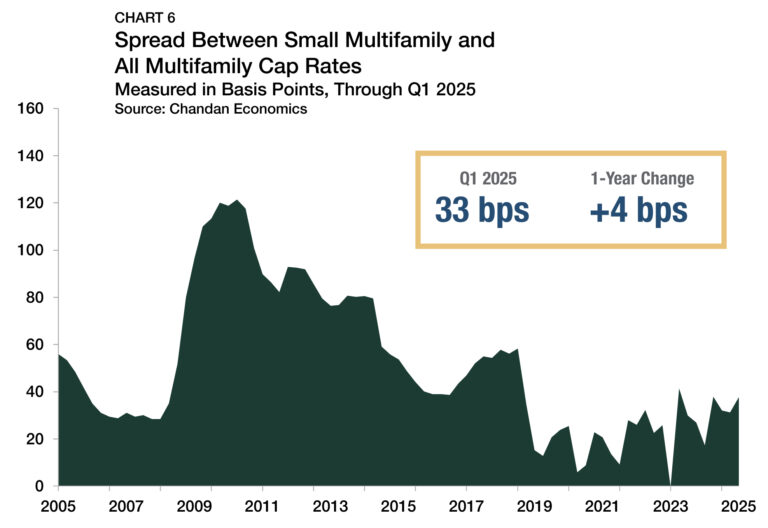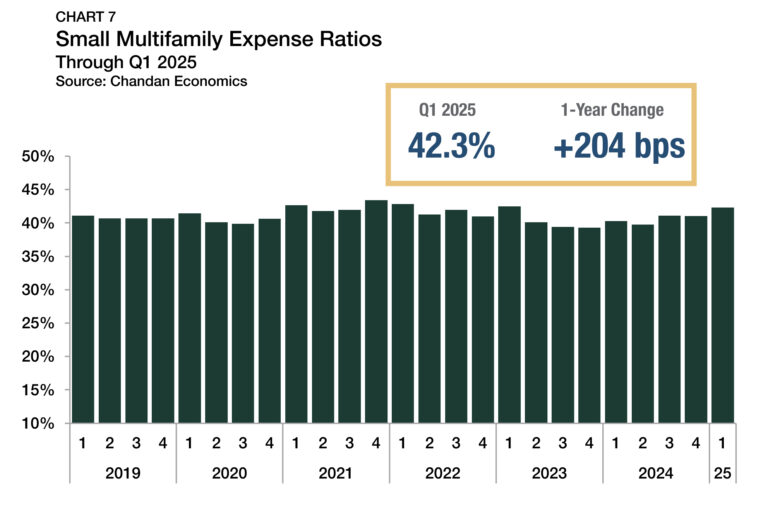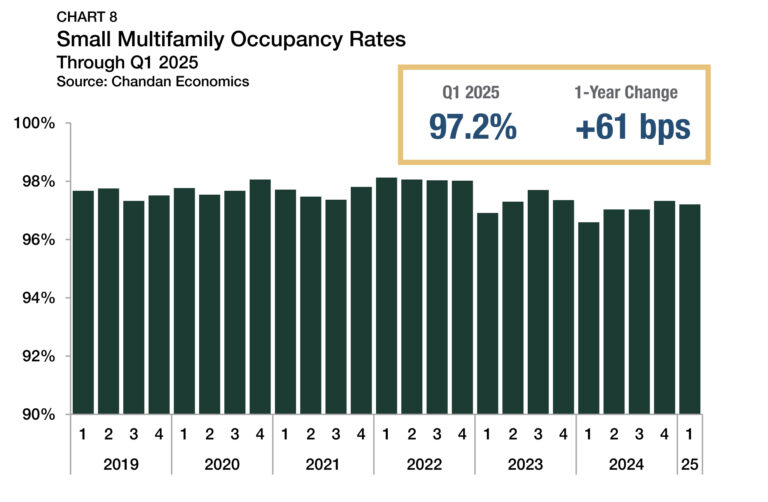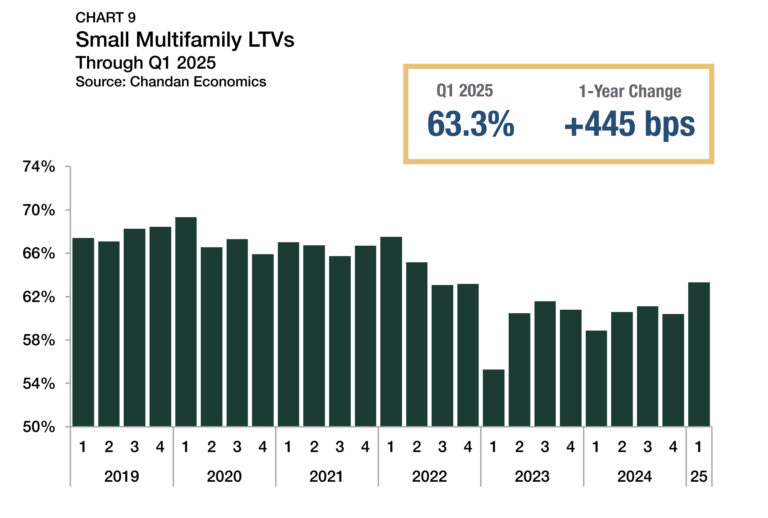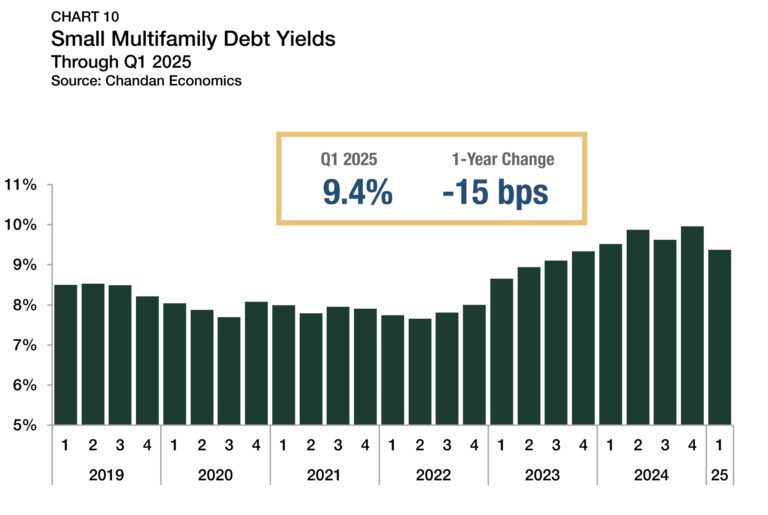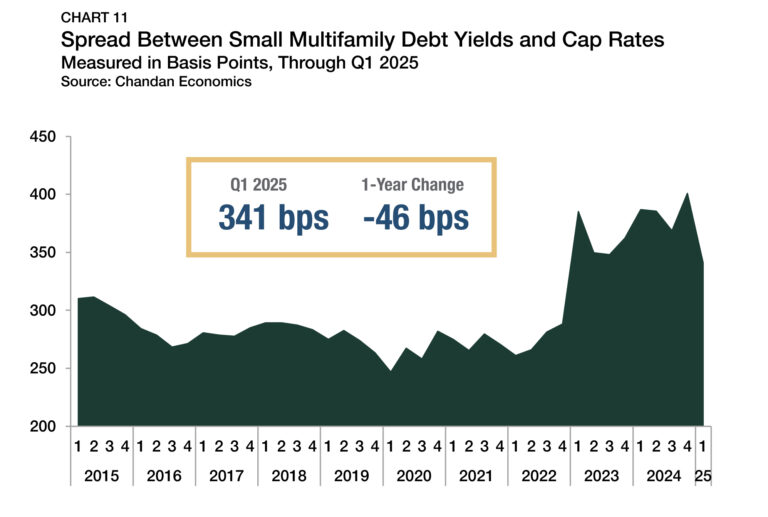FRDDIE MAC® Conventional Forwards Arbor’s Freddie Mac® Conventional Forwards encourage the creation of new housing supply by providing takeout certainty to developers and construction lenders, helping to address long-term supply shortages that limit affordability and housing choice. In an evolving multifamily lending environment, our Conventional Forwards provide clarity to the terms of the permanent debt needed when a property stabilizes after new construction or major rehabilitation.
Small Multifamily Investment Trends Report Q2 2025
Asset Valuations Hold Steady as Credit Conditions Improve
Key Findings
- Small multifamily valuations held steady in the first quarter of 2025.
- Revised estimates of 2024 origination volume increased the annual total by 28%.
- Debt yields fell, and LTVs jumped as credit standards eased.
State of the Market
The small multifamily sector, which includes multifamily properties, between five and 49 units, remains firmly grounded even as broader capital markets react to shifting expectations surrounding monetary policy. As markets rapidly recalibrate, futures markets priced in four interest rate cuts before year-end, as of late April.
Supported by resilient fundamentals, the small multifamily sector safely navigated a first quarter defined by hyper-volatility. According to the National Multifamily Housing Council’s Q1 2025 Survey of Apartment Conditions, market tightness, sales volume, and capital availability showed measurable improvement during the first quarter.
The need for quality affordable housing options remains a pivotal underlying strength of multifamily real estate investing, as lifestyle renters, Generation Z, and Baby Boomers drive up rental housing demand. Rental households accounted for the majority of household formations last year — an impressive feat considering renters only make up about 30% of all households.
Once again, small multifamily demonstrated its comparative resilience in the first quarter of 2025. Pricing stabilized, origination activity improved, and credit standards gained momentum toward pre-pandemic benchmarks. Amid ongoing macroeconomic uncertainty, the small multifamily sector remains well-positioned to weather volatility and build on market momentum as the economy navigates stormy conditions.
Lending Volume
Small multifamily lending activity was higher than originally reported last year. The revised 2024 year-end estimate of new multifamily lending volume on loans with original balances between $1 million and $9 million1 (including loans for apartment building sales and refinancing) increased to $56.8 billion — reflecting a surge of deal activity in the fourth quarter (Chart 1).
2024’s production represented a 27.7% annual increase, bringing market activity back in line with pre-pandemic levels. During the first quarter of 2025, new small multifamily originations matched last year’s pace, with the current annualized estimate relatively unchanged.
1 All data, unless otherwise stated, are based on Chandan Economics’ analysis of a limited pool of loans with original balances of $1 million to $9.0 million and loan-to-value ratios above 50%.
Loans by Purpose
High interest rates have reduced the incentive for investors to pursue loan refinancings. After hitting a recent high of 75.6% in the third quarter of 2022, the refinancing share of small multifamily originations fell substantially to reach a low point of 60.5% in the second quarter of 2023 (Chart 2). However, the share has recovered and moderated over the past six quarters, ranging between 66.8% and 72.7%, and finished the first quarter of 2025 at 68.6%.
Arbor Small Multifamily Price Index
According to the Arbor Small Multifamily Price Index, asset valuations are down 2.7% from a year earlier through the first quarter of 2025 (Chart 3), marking the eighth consecutive quarter of annual price declines. Despite negative annual growth, there is still optimism that valuations are stabilizing. On a quarterly basis, prices have risen or held steady in each of the past three quarters.
Compared to a mid-2024 low point, small multifamily prices were up by 2.3% at the end of the first quarter of 2025. Underlying the pricing stabilization were a few factors trending in opposite directions. Cap rates ticked up, albeit marginally, which worked against pricing momentum. At the same time, property-level revenues increased as the rate of rent growth moved higher, providing a slight tailwind. The net effect was that small multifamily prices were essentially unchanged during the quarter.
Cap Rates & Spreads
Small multifamily cap rates averaged 6.0% during the quarter, almost unchanged from the fourth quarter of 2024 (Chart 4). After cap rates rapidly rose to the 6.0% range in the second quarter of 2024, they have held steady despite significant interest rate volatility. Over the past four quarters, small multifamily cap rates have sat in an exceptionally narrow eight bps range. Compared to the cyclical low point of 4.9% in the first quarter of 2023, cap rates have climbed by a cumulative 116 bps. Although elevated cap rates negatively weighed on asset valuations over the past two years, they have also improved the return profile of the sector for prospective investors.
The small multifamily risk premium, measured by comparing cap rates to the yield on the 10-year Treasury, approximates the additional compensation that investors require to account for higher levels of risk. This risk premium compressed by 17 bps in the first quarter of 2025 to reach 152 bps (Chart 5). The drop-off occurred as 10-year Treasury yields averaged 4.5% between January and March 2025, rising from 4.3% at the end of 2024.
As long-term government bond yields have risen over the past half-year, momentum towards re-establishing an equilibrium risk premium in line with pre-pandemic trends has stalled. Between 2015 and 2019, the small multifamily risk premium averaged 369 bps — more than double the current spread. The small multifamily/Treasury risk premium remained below 200 bps for the past 11 consecutive quarters.
At the same time, the cap rate spread between small multifamily assets and the rest of the multifamily sector, a measure of the risk unique to smaller properties, increased by five bps during the first quarter to reach 38 bps (Chart 6). This risk premium averaged a comparable 42 bps over the five years preceding the pandemic, demonstrating that perceptions of the comparative riskiness of small assets remained stable.
Expense Ratios
Expense ratios, measured as the relationship between underwritten property-level expenses and gross income, climbed by 128 bps in the first quarter of 2025 to 42.3% (Chart 7). Large single-quarter swings in expense ratios are typical. More than half of all quarterly movements are greater than 75 bps. Still, as insurance prices continue rising and given the potential for tariffs to cause higher maintenance costs, expense ratios are an area to watch in the months ahead.
Occupancy Rates
Occupancy rates within small multifamily properties that received financing during the first quarter averaged 97.2% (Chart 8). Compared to the previous quarter, occupancy rates slid by 12 bps. Notably, during the first quarters of 2023 and 2024, occupancy rates fell by 111 bps and 75 bps, respectively.
Compared to the same time last year, underwritten small multifamily occupancy rates are up by a healthy 61 bps. With occupancy rates anchored above 97%, small multifamily properties will remain stable investments.
Small multifamily occupancy rates have routinely outperformed, tracking about 2% higher than the average set across all multifamily properties, which may result from closer tenant-landlord relationships in small buildings. According to a recent report by the Terner Center for Housing Innovation at UC Berkeley, a majority of small multifamily property owners reported that at least half of their rental units were being leased at below-market-rate rents, primarily to retain quality tenants.
By and large, small multifamily households are moving less today. A recent Chandan Economics analysis of the U.S. Census Bureau’s American Community Survey found that 58.3% of existing small multifamily households have lived in their current unit for at least two years — 3.4 percentage points higher than in large multifamily (50+ units) properties.
Leverage & Debt Yields
Shifting underwriting trends were the most significant area of change within the small multifamily sector during the first quarter of 2025. Loan-to-value ratios (LTVs) soared to 63.3%, rising 291 bps in the first three months of the year (Chart 9). LTVs tend to have high levels of quarter-to-quarter variability, as they are responsive to both lenders’ underwriting criteria and borrower preferences. Still, the first-quarter increase is noteworthy. The last time small multifamily LTVs finished a quarter higher than where they are today was the second quarter of 2022 when the Federal Reserve had just begun its monetary tightening cycle.
A byproduct of the same economic climate, average debt yields sank in the first quarter, falling by 58 bps to 9.4% (Chart 10). During the previous quarter, small multifamily debt yields reached their highest point in over a decade. However, in early 2025, the tables turned quickly and small multifamily debt yields reached a five-quarter low.
The inverse of debt yield, measured as debt per dollar of net operating income (NOI), increased for the second time in the past 11 quarters. In the first quarter of 2025, small multifamily borrowers secured an average of $10.67 in new debt for every $1.00 of property NOI, up $0.62 from the previous quarter and $0.16 from the same time last year.
With cap rates inching higher and debt yields falling during the first quarter, the spread between the two measures narrowed substantially to 341 bps (Chart 11). While the spread remains elevated compared to its 2015-2019 average of 284 bps, the first quarter movement was a significant step towards normalization. Spreads had risen as lenders became more risk-averse than prospective buyers. The momentum back towards pre-pandemic spreads suggests that lenders are becoming more confident in prevailing valuations and the reliability of net operating incomes (NOIs). NMHC’s Quarterly Survey of Apartment Conditions supports these findings. In the first quarter of 2025, the survey’s debt financing index had the fourth-largest single-quarter jump since the end of the Great Recession.
Outlook
As the year’s midpoint approaches, the small multifamily sector is poised to maintain stability and strength with the support of solid housing demand and stabilizing capital markets.
The macroeconomic backdrop at the moment, particularly as it relates to tariffs and inflation, is in flux. For small multifamily owners, a meaningful increase in the price of raw materials and appliances will translate to higher development and operating costs. But, at the same time, multifamily assets remain an attractive hedge against inflationary pressures as lease terms reset annually. As a result, increased investment capital could target the multifamily sector, which would be a boon for valuations.
While uncertainties linger, small multifamily is in a strong position. Its role in meeting the persistent need for affordable rental housing will allow the sector to withstand business cycle headwinds and benefit from structural tailwinds over the long term.
For more small multifamily research and insights, visit arbor.com/articles
Disclaimer
This report is intended for general guidance and information purposes only. This report is under no circumstances intended to be used or considered as financial or investment advice, a recommendation or an offer to sell, or a solicitation of any offer to buy any securities or other form of financial asset. Please note that this is not an offer document. The report is not to be considered as investment research or an objective or independent explanation of the matters contained herein and is not prepared in accordance with the regulation regarding investment analysis. The material in the report is obtained from various sources per dating of the report. We have taken reasonable care to ensure that, and to the best of our knowledge, material information contained herein is in accordance with the facts and contains no omission likely to affect its understanding. That said, all content is provided herein “as is” and neither Arbor Realty Trust, Inc. or Chandan Economics, LLC (“the Companies”) nor their affiliated or related entities, nor any person involved in the creation, production and distribution of the content make any warranties, express or implied. The Companies do not make any representations or warranties, express or implied, as to the reliability, usefulness, completeness, accuracy, currency nor represent that use of any information provided herein would not infringe on other third-party rights. The Companies shall not be liable for any direct, indirect or consequential damages to the reader or a third party arising from the use of the information contained herein. There may have been changes in matters which affect the content contained herein and/or the Companies subsequent to the date of this report. Neither the issue nor delivery of this report shall under any circumstance create any implication that the information contained herein is correct as of any time subsequent to the date hereof or that the affairs of the Companies have not since changed. The Companies do not intend, and do not assume any obligation to update or correct the information included in this report. The contents of this report are not to be construed as legal, business, investment or tax advice. Each recipient should consult with its legal, business, investment and tax advisors as to legal, business, investment and tax advice. The information contained herein may be subject to changes without prior notice. This report is only intended for the recipients, and should not be copied or otherwise distributed, in whole or in part, to any other person.


